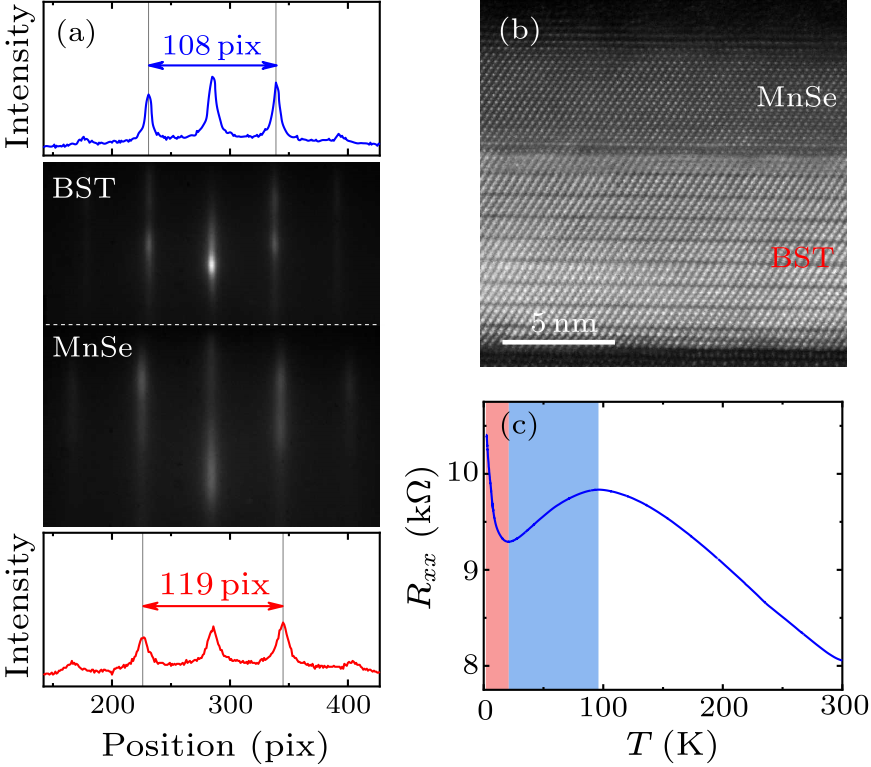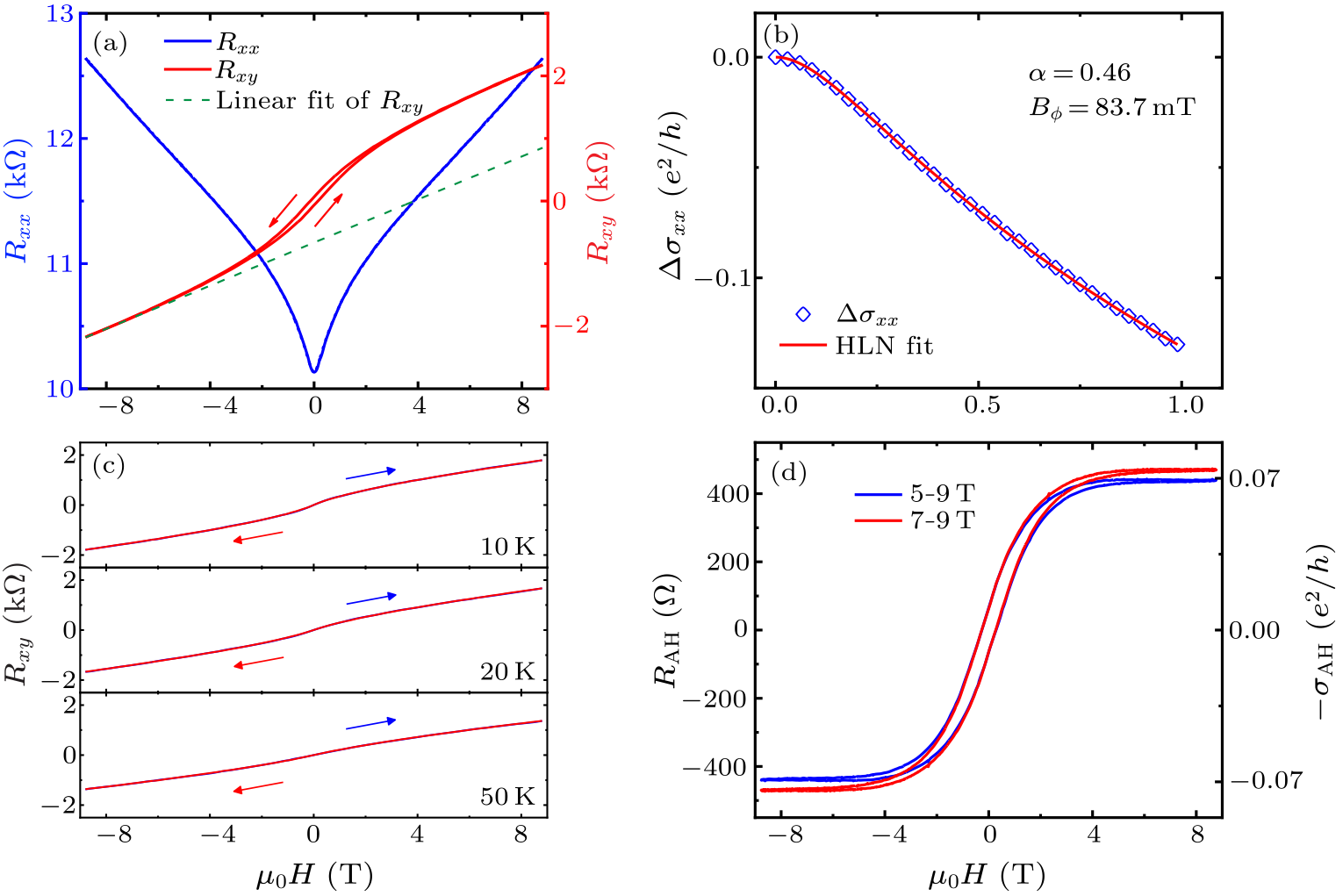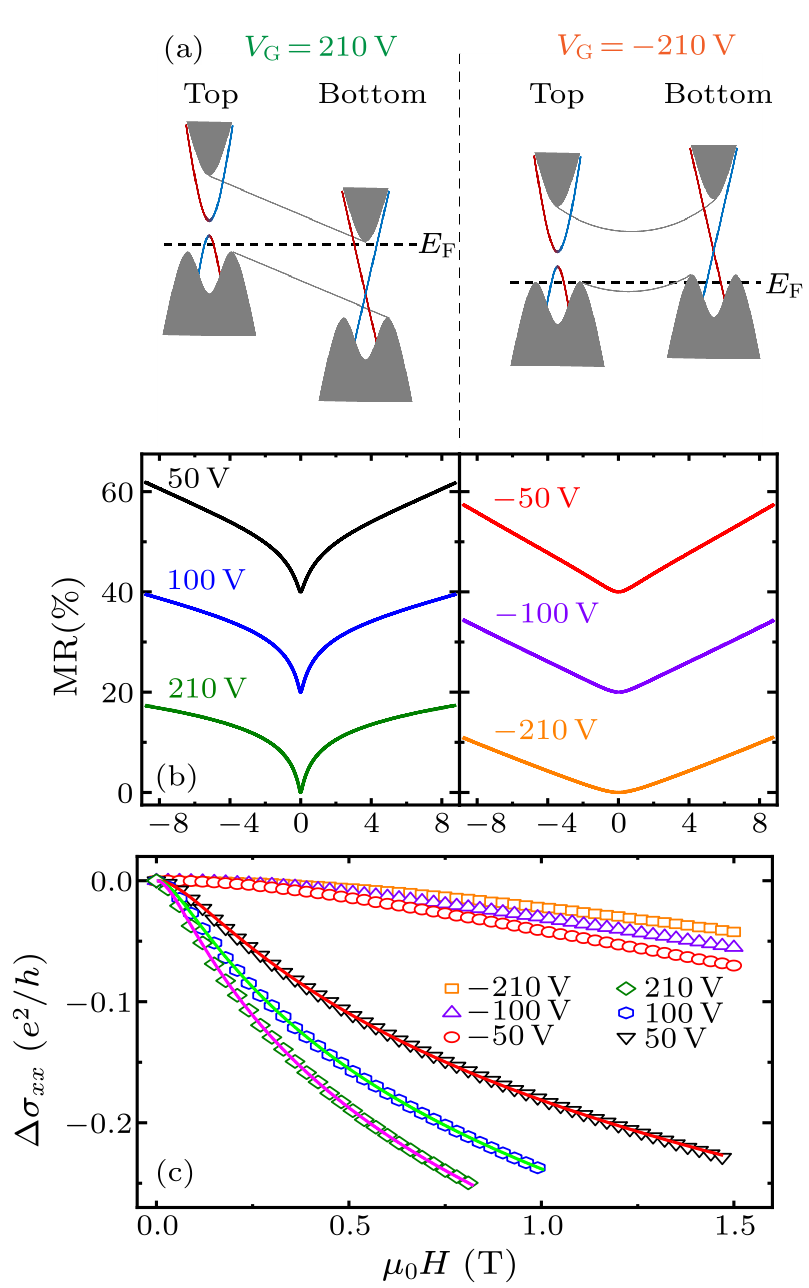Erratum: 2021 Chin. Phys. Lett. 38 109901

Fig. 1. Basic characterization of MnSe/(Bi,Sb)$_{2}$Te$_{3}$ heterostructures grown on STO(111) substrates. (a) RHEED patterns of (Bi,Sb)$_{2}$Te$_{3}$ (BST) and MnSe layers and the corresponding intensity peaks. (b) Cross-sectional TEM image of a MnSe/BST (6 nm/9 nm) heterostructure. (c) Temperature dependence of $R_{xx}$ of a MnSe/BST (3 nm/8 nm) heterostructure.

Fig. 2. Transport properties of the MnSe/BST heterostructure (sample A) without gating. (a) Magnetic field dependence of $R_{xx}$ (blue) and $R_{xy}$ (red) at $T = 1.6$ K. The arrows (red) denote magnetic field sweeping direction. The dashed line (green) is obtained from a linear fit of the $R_{xy}$ data from $-$8.8 T to $-$8 T. (b) Magnetoconductivity curve (symbols) and its fit to the HLN equation (line). (c) Hall effect curves taken at 10 K, 20 K and 50 K. (d) Anomalous Hall resistances extracted by subtracting the nonlinear background with two different fitting ranges: 5–9 T (blue) and 7–9 T (red).

Fig. 3. Gate voltage of the Hall effect in the MnSe/BST heterostructure at $T = 1.6$ K. (a) Hall resistance curves measured at $V_{\rm G}=-100$ V, 0 V and 100 V. (b) Gate-voltage dependence of $R_{xx}$ at zero magnetic field (red line) and the anomalous Hall conductivity $\sigma_{_{\scriptstyle \rm AH}}^{\rm s}$ at $\mu_{0}H = 8.8$ T (blue diamonds).

Fig. 4. Band diagrams and the gate-voltage dependence of longitudinal transport properties of the MnSe/BST heterostructure. (a) Schematic band diagrams of the BST layer for $V_{\rm G} = 210$ V and $-$210 V. (b) Magnetoresistances recorded at six different gate voltages. Some of the MR curves are shifted vertically for clarity. (c) Corresponding magnetoconductance curves (symbols) taken at the same voltages.
| [1] | Fu L and Kane C L 2007 Phys. Rev. B 76 045302 | Topological insulators with inversion symmetry
| [2] | Chang C Z, Zhang J, Feng X, Shen J et al. 2013 Science 340 167 | Experimental Observation of the Quantum Anomalous Hall Effect in a Magnetic Topological Insulator
| [3] | Qi X L, Hughes T L, and Zhang S C 2008 Phys. Rev. B 78 195424 | Topological field theory of time-reversal invariant insulators
| [4] | Jiang G, Feng Y, Wu W, Li S et al 2018 Chin. Phys. Lett. 35 076802 | Quantum Anomalous Hall Multilayers Grown by Molecular Beam Epitaxy
| [5] | Qi X L, Li R, Zang J, and Zhang S C 2009 Science 323 1184 | Inducing a Magnetic Monopole with Topological Surface States
| [6] | Wei P, Katmis F, Assaf B A, Steinberg H et al 2013 Phys. Rev. Lett. 110 186807 | Exchange-Coupling-Induced Symmetry Breaking in Topological Insulators
| [7] | Jiang Z, Chang C Z, Tang C, Zheng J G et al 2016 AIP Adv. 6 055809 | Structural and proximity-induced ferromagnetic properties of topological insulator-magnetic insulator heterostructures
| [8] | Che X, Murata K, Pan L, He Q L et al 2018 ACS Nano 12 5042 | Proximity-Induced Magnetic Order in a Transferred Topological Insulator Thin Film on a Magnetic Insulator
| [9] | Tang C, Chang C Z, Zhao G, Liu Y et al 2017 Sci. Adv. 3 e1700307 | Above 400-K robust perpendicular ferromagnetic phase in a topological insulator
| [10] | Yang W, Yang S, Zhang Q, Xu Y et al 2014 Appl. Phys. Lett. 105 092411 | Proximity effect between a topological insulator and a magnetic insulator with large perpendicular anisotropy
| [11] | Mogi M, Nakajima T, Ukleev V, Tsukazaki A et al 2019 Phys. Rev. Lett. 123 016804 | Large Anomalous Hall Effect in Topological Insulators with Proximitized Ferromagnetic Insulators
| [12] | Watanabe R, Yoshimi R, Kawamura M, Mogi M et al 2019 Appl. Phys. Lett. 115 102403 | Quantum anomalous Hall effect driven by magnetic proximity coupling in all-telluride based heterostructure
| [13] | Baltz V, Manchon A, Tsoi M, Moriyama T et al 2018 Rev. Mod. Phys. 90 015005 | Antiferromagnetic spintronics
| [14] | Luo W and Qi X L 2013 Phys. Rev. B 87 085431 | Massive Dirac surface states in topological insulator/magnetic insulator heterostructures
| [15] | Eremeev S V, Men'shov V N, Tugushev V V, Echenique P M et al 2013 Phys. Rev. B 88 144430 | Magnetic proximity effect at the three-dimensional topological insulator/magnetic insulator interface
| [16] | Makovetskii G I and Galyas A I 1982 Fiz. Tverd. Tela (Leningrad) 24 2753 |
| [17] | Matetskiy A V, Kibirev I A, Hirahara T, Hasegawa S et al 2015 Appl. Phys. Lett. 107 091604 | Direct observation of a gap opening in topological interface states of MnSe/Bi 2 Se 3 heterostructure
| [18] | Liu N, Niu X, Liu Y, Zhang Q et al 2020 Phys. Rev. Mater. 4 094204 | Anomalous Hall effect in a magnetically extended topological insulator heterostructure
| [19] | Jacobson A J and Fender B E F 1970 J. Chem. Phys. 52 4563 | Covalency Parameters in MnSe and MnSe 2
| [20] | Anoop M D, Yadav N, Yadav J, Singh R et al 2020 Mater. Today: Proc. 31 622 | Growth and structural characterization of BiSbTe3-ySey single crystals
| [21] | Alegria L D, Ji H, Yao N, Clarke J J et al 2014 Appl. Phys. Lett. 105 053512 | Large anomalous Hall effect in ferromagnetic insulator-topological insulator heterostructures
| [22] | Chen J, He X Y, Wu K H, Ji Z Q et al 2011 Phys. Rev. B 83 241304 | Tunable surface conductivity in Bi Se revealed in diffusive electron transport
| [23] | Chen J, Qin H J, Yang F, Liu J et al 2010 Phys. Rev. Lett. 105 176602 | Gate-Voltage Control of Chemical Potential and Weak Antilocalization in
| [24] | Hikami S, Larkin A I, and Nagaoka Y 1980 Prog. Theor. Phys. 63 707 | Spin-Orbit Interaction and Magnetoresistance in the Two Dimensional Random System
| [25] | Lu H Z, Shi J, and Shen S Q 2011 Phys. Rev. Lett. 107 076801 | Competition between Weak Localization and Antilocalization in Topological Surface States
| [26] | Ashcroft N W and Mermin N D 1976 Solid State Physics (Orlando: Saunders College Publishing) p 240 |
| [27] | Kong D, Chen Y, Cha J J, Zhang Q et al 2011 Nat. Nanotechnol. 6 705 | Ambipolar field effect in the ternary topological insulator (BixSb1–x)2Te3 by composition tuning
| [28] | Abrikosov A A 1998 Phys. Rev. B 58 2788 | Quantum magnetoresistance
| [29] | Wang C M and Lei X L 2012 Phys. Rev. B 86 035442 | Linear magnetoresistance on the topological surface
| [30] | Guan T, Teng J, Wu K H, and Li Y Q 2015 Acta Phys. Sin. 64 077201 (in Chinese) | Linear magnetoresistance in topological insulator (Bi0.5Sb0.5)2Te3 thin films